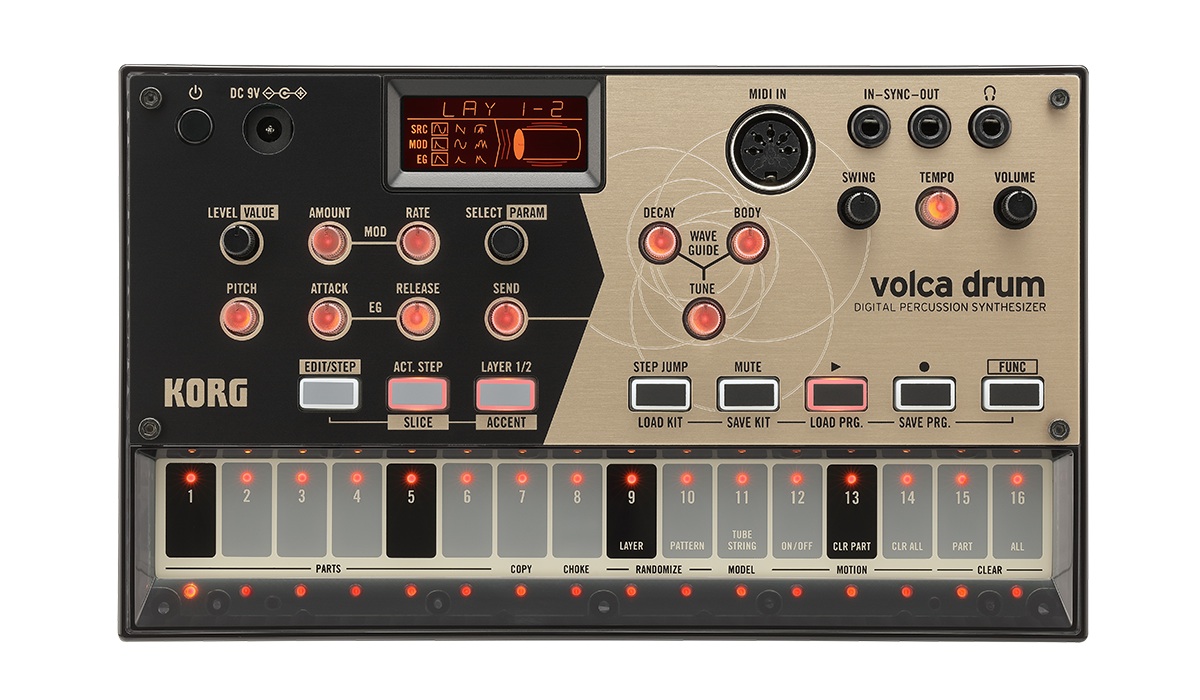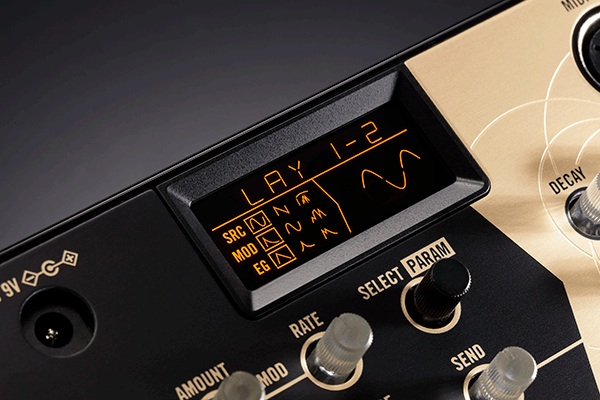New Gear Review: volca Drum Synthesizer by Korg

Korg introduces the volca Drum, a powerful new percussion synthesizer, into their popular vocal series.
Despite the fact that Korg already has two drum machines in their volca series (the Beats and the Kick), the announcement of the new volca Drum was met with considerable applause. Perhaps this is because thus far, the volca Drum bears the closest lineage to the much-loved Korg Electribe ER-1, a PCM-based XOX machine that was the first “groovebox” for many burgeoning producers.
Similarly, the new volca Drum is a labeled a “Digital Percussion Synthesizer,” as if to show it is more versatile than being “just” a drum machine—and it indeed is capable of more than just drum sounds. Its six voices all share the same architecture and, like the new volca Modular, the sequencer in the volca Drum introduces a few new twists on what’s come before in the volca lineup.
Features
The volca Drum is an all-digital drum machine, unlike the previously-released volca Beats, which had both analog and digital components, and the all-analog volca Kick, based around the famous MS-20 filter. The fact that the volca Drum is digital is going to become moot when hearing it through a good set of monitors, as it sounds robust, crisp, deep, booming, and all things in between.
Like all volcas, it boasts the usual configuration of sync in and out jacks, a headphone/main output, MIDI in jack, and can be powered by either 9V or six AA batteries. As you most likely know by now if you’ve encountered any of the volca series, the machine itself is minuscule—about the size of a VHS cassette.
The onboard architecture is quite easy to understand; programming sounds becomes intuitive once you’ve done it a few times. There are six parts, with two layers per part. Parts can be identical; i.e. there can be a variation of a kick sound for all six voices. You are not limited to the normal array of one (or two) kick drums, one snare, one closed hi hat, one open hi-hat, etc. Each part can be programmed to have a more melodic timbre as well, given the fact that the pitch of the oscillators are controlled by a knob on the front panel that can be motion sequenced. More on that later.
Each layer can be edited individually or both at once, though it’s a bit fiddly to edit both at once because the icons on the screen flash to indicate which layer is currently shown. Luckily, the screen on the volca Drum is all-new and a pleasure to use.
Each layer is made up of an oscillator, a simple modulation envelope, and an amp envelope. The oscillator has five options, three of which are filtered noise of the usual variants (low pass, high pass, and band pass). The modulation choices are a simple rise-fall envelope, a sine wave LFO, or a random generator. Fortunately, modulation can be applied in either negative or positive directions. The amplitude envelope has three options as well: linear sweep, exponential, and multi-peak attack.
Each layer has further customization options that can be programmed, though these are hidden under a Function key press, which is a bit of a shame. These options are crucial to accessing the full capabilities of the volca Drum’s sound engine, as there are menus for bit depth, distortion, pan, wavefolding, and overall gain. As you can imagine, tweaking these values is where you’ll really be able to personalize each part’s timbre.
Besides knobs for the Mod and EG sections, there’s the aforementioned Pitch knob, as well as the Send knob (which can be applied per part) to the Waveguide Resonator, one of the most unique features of the volca Drum. The Waveguide Resonator has two physical modeling options: tube and string. If you’ve used Ableton’s Corpus plugin, you’re familiar with the concept and resultant sound, and playing with the Waveguide is where the timbral depth of the Korg volca Drum really becomes apparent.
This is especially true when taking into account the fact that the Decay, Body, and Tune parameters of the Waveguide can be automated per step using the volca system of motion sequencing. The Waveguide can sound at times like a pseudo-reverb or even a modulated delay with shorter time settings, and totally transforms the sound of the oscillators in a pleasing way. More than an effect, it feels like an integrated part of the instrument given its ties to the sequencer, which has its own unique strengths.
Sixteen kits can be stored and recalled, and (importantly) include Waveguide Resonator settings. Kits also now have the ability to store choke settings, another new volca feature. Kit parameters can also be controlled with MIDI CC values, making the volca Drum an effective drum module when sequenced and controlled from your DAW.
The sequencer functionality has been expanded in the volca Drum as well, in subtle but important ways. Patterns can be sixteen steps long, with the ability to use the Active Step feature to remove and add steps into your pattern in real time. Active Step can also be applied per part, which is new to the volca series and makes it easy to slip into a polyrhythmic groove.
Just like the volca FM, patterns can be chained together, though these chains can’t be saved after powering down. The volca Drum also allows for step recording, as does the volca Modular (this was not a feature on many of the previous volca models, confusingly). Motion sequencing can add a lot of life to your patterns, and since it’s possible to turn off motion sequencing without erasing your knob movements, this can effectively add an A/B setting to each pattern.
A few other new features are hidden within the depths of the sequencer but greatly expand what the volca Drum is capable of. The first is a new ”Slice” feature, which lets you select the timing and create drum rolls or trills on a per-step basis, allowing the volca Drum to slide into trap territory quite easily.
There are now also sixteen levels of accent, allowing there to be far more variation in the velocity of your patterns. Most impressive is the new ability to add probability to each step, which is glossed over quite quickly in the skint manual and very easy to miss! This is done by holding down a step and turning the Level knob; this feature pushes the volca Drum into territory usually occupied with machines labeled with the Elektron logo.
A new “Step Jump” feature only plays back the selected steps, allowing you to easily create beat repeat-like build ups. Furthermore, a new Randomize function can either be applied to the notes of your sequence or to all settings of the pattern itself (active steps, slice per step, accent, and notes). Using the Randomize function means there can be a lot of variation to explore within just a single pattern.
In Use
The volca Drum can be used in two ways, depending on your setup. It can be controlled via MIDI from your DAW, and sequenced as a sound module. It functions well in this regard; Korg has thought ahead this time and given you the ability to put each part on its own MIDI track, or have the entire device on one track. This is different from the MIDI implementation on the volca Sample, which left many users scratching their heads.
But using the built-in sequencer along with the sound engine is how most users are going to make their way into the universe of the volca Drum. It’s very easy to get lost in creating patterns using the Randomize function, starting in one point but ending in a totally new one. Having the Swing knob on the front panel is also handy for pushing notes just slightly off the grid.
The sound palette of the volca Drum leans toward the rough and characterful side, despite its digital nature. Having the choice of three noise oscillators with different pre-applied filters is a quick way to avoid fiddling with filters within the architecture of the signal path. As you’d expect, this machine is able to go down into the very low sub octaves, and can sing in the higher octaves as well, with all sorts of ping-like sounds—especially when sending parts into the Resonator.
To Be Critical
Given the dual layers of each part, creating fairly complex sounds with the volca Drum is possible. However this is where the unit falters a bit, as programming sounds is a bit more fiddly than you’d expect. It’s somewhat tedious to scroll through pre-selected combinations of oscillator and modulator waveforms. Given the available real estate on this panel, Korg could have included separate knobs for oscillator and modulator waveform selections.
Additionally, it would have been nice if some of the expanded controls had their own knobs, especially drive and bit depth. The randomize functionality added a lot of fun to the volca Drum, but would have been more useful if there was some way to rein it in slightly. Sometimes the sounds it generated were borderline unusable in any musical context.
Summing it Up
Korg’s volca Drum is a bit of a head-scratcher. On the one hand, the pure sonic weight and thrust of the oscillators combined with the Waveguide Resonator means that the volca Drum is certainly going to impress when heard through a proper system. While certainly able to handle house, techno, trap, hip hop, and more, the volca Drum excels when pushed to its boundaries, spewing out experimental-leaning beats that are primed to make use of its unique Motion Sequencing.
Dig a bit deeper into it though, and you might grow tired of its dual layer/single knob approach to programming. And given the fact that some of the best features (bit reduction, drive, probability, and accents) are all hidden within secondary menus, the volca Drum’s place in your workflow might change after dealing with some cramping hands and tired fingers.
That being said, if you’re seeking an affordable drum machine ($149.99 MSRP) with a bit of a different flavor, and one that is going to yield results that will push you in a more experimental direction, the volca Drum is certainly for you. As for the rest of us, we still can’t wait to see what comes next in the volca series. Well done, Korg.
Leo Maymind is a producer, DJ, and writer living in Los Angeles, CA. He is obsessed with sound, and you can reach him at lmaymind@gmail.com.
Please note: When you buy products through links on this page, we may earn an affiliate commission.







